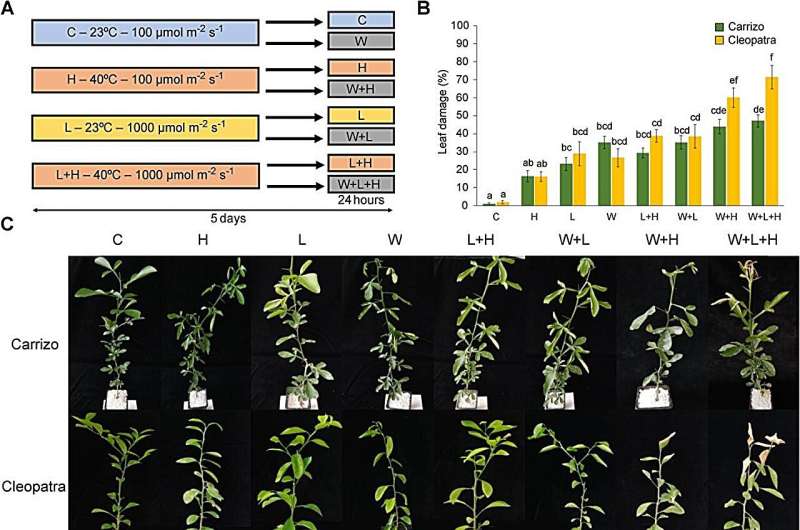This article has been reviewed according to Science X's editorial process and policies. Editors have highlighted the following attributes while ensuring the content's credibility:
fact-checked
peer-reviewed publication
trusted source
proofread
Multifactorial stress in citrus: Divergent responses of Carrizo and Cleopatra to triple threat environmental challenges

Climate change, alongside human-induced adverse factors, threatens agricultural production and food security by causing stressful situations for plants, such as increased temperatures, extreme weather events, pest outbreaks, diseases, and pollution.
Current research delves into plant responses to these adverse conditions to inform improved agricultural practices and plant breeding. Notably, plants often face multiple stressors simultaneously, with most combinations having a synergistic impact, amplifying the stress on plants.
Despite the extensive study of dual-stress effects, there's a limited understanding of the impact of three or more concurrent stress factors, which can severely hinder plant growth. Therefore, comprehensively examining multifactorial stress combinations is critical to optimizing plant resilience and agricultural output.
In May 2023, Horticulture Research published a research paper entitled "Omics analyses in citrus reveal a possible role of RNA translation pathways and Unfolded Protein Response regulators in the tolerance to combined drought, high irradiance, and heat stress."
In this study, leaf damage in Carrizo and Cleopatra citrus plants was examined under various individual and combined abiotic stress conditions. The results indicated that heat stress (H) alone did not lead to notable leaf damage. However, high irradiance (L) and water stress (W) resulted in leaf damage ranging between 23% and 35% for both genotypes.
Combinations of stresses, notably L+H and W+L, also produced significant damage, with Cleopatra plants showing up to 60% leaf damage under the W+H condition and 71% under the triple stress combination of W+L+H. Carrizo, on the other hand, showed consistent damage percentages similar to two-factor stress combinations. A deeper dive into the plants' responses utilized transcriptomic and proteomic analyses.
In terms of differentially regulated transcripts (DRTs), the triple stress combination (W+L+H) led to the highest number of DRTs for both genotypes. Analysis of differentially accumulated proteins (DAPs) revealed that heat stress, whether individual or combined, caused significant changes in DAPs for both citrus types.
Principal component analyses (PCA) showcased the substantial differences between the genotypes, and transcription factors also showed varied expression patterns between the two genotypes in response to different stress conditions.
Furthermore, common responses between Carrizo and Cleopatra under various stresses were investigated. A key finding was the significant role of the "protein processing in ER" pathway in reacting to different stress conditions, with both genotypes showcasing upregulation of transcripts related to this pathway. However, their response differed when exposed to the combined stress of W+L+H.
An analysis focused on the unique responses of the plants to the triple stress combination revealed that over 95% of the upregulated transcripts were genotype-specific, emphasizing the distinct ways Carrizo and Cleopatra react to the same stress conditions. Additionally, translation pathway regulation in the plants varied according to the stresses and the genotype, with Carrizo typically showing a higher number of DAPs than Cleopatra under most stress conditions.
In summary, the Carrizo and Cleopatra citrus plants exhibited varied levels of leaf damage and molecular responses under different stress combinations. The discovery of key proteins and regulatory mechanisms can guide future crop improvement strategies, equipping citrus plants to better withstand the challenges of changing climatic conditions.
More information: Damián Balfagón et al, Omics analyses in citrus reveal a possible role of RNA translation pathways and Unfolded Protein Response regulators in the tolerance to combined drought, high irradiance, and heat stress, Horticulture Research (2023). DOI: 10.1093/hr/uhad107
Journal information: Horticulture Research
Provided by NanJing Agricultural University





















